New Tech Tools Extend Libraries’ Reach
People are always a library’s greatest assets. The trained and experienced staff who interact with patrons, answer questions, recommend resources, lead story hours, and oversee workshops are what make libraries a vibrant and essential part of their communities. But librarians can’t be everywhere all at once. This is where technology can help.


People are always a library’s greatest assets. The trained and experienced staff who interact with patrons, answer questions, recommend resources, lead story hours, and oversee workshops are what make libraries a vibrant and essential part of their communities.
But librarians can’t be everywhere all at once. Too often, they’re challenged to fulfill an ever-increasing number of roles and responsibilities with fewer resources. Much of their time is occupied with tedious tasks that take them away from their most important job: engaging with the library’s users.
This is where technology can help. Self-service systems empower a library’s guests to check out materials for themselves, so librarians aren’t stuck behind a desk all day. Mobile point-of-sale solutions like the ones used by major retail outlets give librarians the ability to roam the building and interact with patrons, answering questions and having conversations in lounge areas and in the stacks. Easy-to-use software platforms allow the public to reserve meeting rooms, sign up for events, and take care of other routine tasks simply and efficiently, freeing librarians to engage with patrons on a deeper level.
New tech tools also extend the reach of libraries into other parts of the community. They give librarians powerful insights that help them attract more users with highly relevant programs and activities. This results not only in deeper engagement, but also broader use of library resources.
Here are some of the latest technology tools that are supporting the work of librarians and enabling them to be more effective.
FacilitySight
Columbus, Ohio-based FacilitySight helps libraries monitor their building occupancy, keep patrons safe, and forecast usage so they can staff more effectively. “We work to make safe spaces even safer,” says Co-owner Klaus Duren.
FacilitySight installs sensors at each library entrance or exit, as well as strategically throughout the building, to analyze guest movement with industry-leading accuracy. These sensors communicate with the company’s cloud servers in real time through an Ethernet connection, and library administrators can see how many people are in the building at any moment using a data dashboard. The service frees staff from having to count manually, helps ensure compliance with fire safety regulations, and keeps leaders informed about occupancy in the event of an emergency.
A new guest forecasting feature also helps librarians make more informed staffing decisions. Using historical building usage data, combined with information about expected weather patterns, the company’s machine learning models predict future activity with high precision, Duren says.
In addition, FacilitySight protects guests and staff by providing live updates on safety-related events. The company receives real-time information from local and government partners such as FEMA, the National Weather Service, and the National Oceanic and Atmospheric Administration. When a library facility falls inside an alert zone, staff are notified on the dashboard and through email. The system keeps librarians updated about weather alerts, fire warnings, Amber alerts, and local emergencies as new information becomes available.
Yet another service helps patrons avoid having to wait in lines. With a feature called SightLine, libraries can create virtual waitlists for any service in high demand, simplifying the management of queues. The system provides an estimated wait time before guests join the queue and lets them add or remove themselves at any time.
FacilitySight differentiates itself from competitors by offering exceptional customer service and by taking users’ privacy seriously. In fact, the company’s sensors do not store or transmit any images. All information is anonymized, and no personally identifiable information is captured. “We don’t share or sell data to any third parties, and we will never do that,” Duren says
All the company’s services are available for a single yearly licensing fee. No features are hidden behind a paywall or cost extra. Support is free as well, and the company is constantly making enhancements to its software.
Libraries also must pay to install the sensors. However, if a library already has sensors in place, it can use these existing devices with FacilitySight’s solution.
Library Ideas
There are more than 600,000 unfilled computer programming jobs in the United States today, which points to the huge need for employees with coding skills. School and public libraries play a key role in filling this need—and now a new partnership between Library Ideas® and Fiero Code can help.
Fiero Code has developed an online Learn to Code service built specifically for libraries. The service includes a gamified learning environment that teaches people ages eight and up how to code, as well as on-demand training that gives librarians the skills they need to launch a coding club or camp at their library facility.
With offices in Fairfax, VA and Chattanooga, Tennessee, Library Ideas is a global media company providing innovative digital solutions to libraries worldwide. As of March 1, Library Ideas will be the exclusive distributor of Fiero Code’s solution to US libraries.
“Leveling the playing field and giving people access to in-demand skills is at the core of what libraries do today,” says Taylor Harriman, director of business development for Library Ideas. “We instantly saw this service as a great fit in our product lineup, as it dovetails nicely with areas we’re already focused on.”

Fiero Code grew out of an afterschool coding club at the Mesa Public Library in Phoenix. Upwards of 50 kids were coming in to learn coding skills each week, and the club’s founders realized they’d found a market for a new service that was in high demand.
Founder and CEO Luke Miller says the company’s Learn to Code service includes enough self-paced content to make someone with no knowledge of coding at all proficient enough to get a job writing code in a wide range of programming languages, including JavaScript, HTML5, CSS, Python, and SQL.
The platform is built around a project-based approach to learning, challenging users with real-world coding projects that make learning fun. It includes a place for users to write and run their own code so they can immediately apply what they’ve learned and get feedback.
Fiero Code’s mission is to help people unlock a hopeful future as they learn new economy skills, Miller says. This mission aligns with the goal of libraries, he notes, and offering coding instruction can help students and patrons find high-paying jobs.
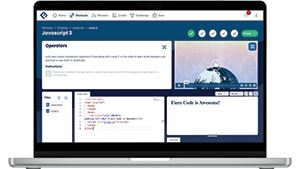 The median starting salary for programming jobs is about $80,000, Miller says, noting: “These are jobs that can have a significant impact on people’s lives. And for many coding jobs, you don’t need to live in a big city—all you need is an Internet connection.”
The median starting salary for programming jobs is about $80,000, Miller says, noting: “These are jobs that can have a significant impact on people’s lives. And for many coding jobs, you don’t need to live in a big city—all you need is an Internet connection.”
Even if patrons aren’t interested in a programming career, learning how to code builds important skills such as problem solving, critical thinking, and creativity—skills that are in high demand in any job environment.
Libraries can purchase the service through Library Ideas for a flat fee that is based on the size of the population they serve. This fee includes unlimited access to the Learn to Code platform for any number of users, as well as unlimited training for library staff in how to lead coding clubs or activities.
For an additional fee, subscribing institutions have access to coding competitions organized by Fiero Code. The company offers three competitions per year, open to students ages 8–18. Participants can win prizes such as robotics kits and drones.
Innovative, Part of Clarivate
Innovative Interfaces Inc. (“Innovative”) of California, now owned by Clarivate, is probably best known for its Sierra and Polaris integrated library systems (ILS) software. However, recognizing the need for libraries to engage with their communities more deeply, Innovative has created a platform—the Vega Library Experience (LX)—and a series of modules around this platform to support better patron engagement.
Vega Promote is an easy-to-use digital marketing automation tool, like Constant Contact or Mailchimp, built specifically for libraries. This cloud-based application allows librarians to manage their contacts, create segmented groups for highly targeted communications, and easily design, schedule, and send professional-looking marketing emails and library notices to their community.
Vega Promote seamlessly integrates with Polaris and Sierra to give users an up-to-date view of all their contacts in a single, secure ecosystem—with no need to build, export, import, and manage multiple email lists across several third-party platforms just to communicate with patrons. Contacts can include email subscribers and anyone else a library has interacted with before, not just card holders.
 The software enables users to send professional-looking emails and notices with no special coding or graphic design skills needed. Vega Promote includes a simple-to-use tool for designing visually appealing emails that can be viewed on either a desktop computer or a mobile device. Users can insert images from an extensive database of free options and customize the design and colors to match their library’s branding.
The software enables users to send professional-looking emails and notices with no special coding or graphic design skills needed. Vega Promote includes a simple-to-use tool for designing visually appealing emails that can be viewed on either a desktop computer or a mobile device. Users can insert images from an extensive database of free options and customize the design and colors to match their library’s branding.
Because many community members look at their library’s website before ever setting foot inside the building, it’s becoming increasingly important for libraries to have a professional-looking website with information that’s both useful and up to date. Vega Promote Web is a website building tool that is easy to use, with no knowledge of HTML coding required. It allows libraries to leave a lasting impression with a beautiful website that meets the needs of their communities.
Like Vega Promote, Vega Promote Web is designed specifically for library patrons, with design templates that include the types of content frequently found on a library’s website. The system is worry-free, with Innovative taking care of the hosting and security for libraries.
Vega Promote Web is flexible enough to fit a library’s unique needs. Website users receive a seamless library experience through integrations with the ILS and third-party applications. With one click, librarians can drag and drop visual showcases or events calendars on as many pages as they’d like. Patrons can search the library’s catalog and log in to their accounts to make updates as needed.
The service includes automated backups, disaster recovery, free HTTPS and SSL certifications, and guidance on search engine optimization (SEO) and accessibility so that librarians can make their websites safe, easily findable, and accessible to all users.

“Our goal is to help libraries spark connections with their communities and better engage with their patrons and potential new users,” says Toni Minick, vice president of product management for Clarivate. “These two products together combine to give the library a toolkit for marketing and communications with their broader community.”
LaptopsAnytime
For more than 15 years, LaptopsAnytime has been a leader in helping libraries and other organizations provide technology services to patrons in a very simple and cost-effective way through self-service lending kiosks. Now, the company is extending its leadership in this area with the introduction of new self-service kiosks designed to help users take advantage of virtual reality (VR) and artificial intelligence (AI) tools as well.
“As new formats emerge for consuming media, we’re doing our best to make it easy for patrons to use these technologies and for libraries to manage them,” says Nathan Criswell, Western US sales manager for LaptopsAnytime.

With the company’s new VR lending kiosks, libraries can offer their patrons what LaptopsAnytime calls “VR as a Service.” The cabinets include sliding drawers for storing, charging, and lending up to three Quest 2 VR headsets and hand controllers per kiosk. A docking station inside each drawer charges the headset and controller automatically when the items are returned.
The purchase of a self-checkout VR kiosk includes a software and maintenance package; a Quest 2 headset, controller, and docking station for each drawer; and a content management system so that libraries can deploy customized content packages for offering their patrons immersive learning experiences using the devices.
AI is transforming so many aspects of our society, Criswell notes, and the emergence of tools such as ChatGPT and DALL-E, an AI-based image generator, is helping to make those who know how to leverage these technologies more productive. Yet, for people who have never used these AI interfaces before, they can be intimidating.
LaptopsAnytime’s new BrainyKiosk is an “AI as a Service” discovery platform for library patrons to experiment with ChatGPT and DALL-E within a safe, non-threatening user environment. This stand-alone, ADA-accessible kiosk includes a 17-inch touch screen, a keyboard, and a graphical user interface developed by LaptopsAnytime.
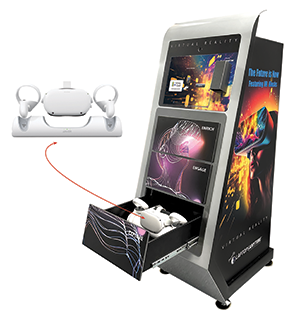 After authenticating with their library card, users can interact with AI tools and send their work to their personal email account using the kiosk’s interface when their session is complete. Libraries can set their own rules and age restrictions for who has access to which types of AI tools. The kiosk requires a 110 Volt outlet and an Ethernet connection.
After authenticating with their library card, users can interact with AI tools and send their work to their personal email account using the kiosk’s interface when their session is complete. Libraries can set their own rules and age restrictions for who has access to which types of AI tools. The kiosk requires a 110 Volt outlet and an Ethernet connection.
“We see this as a valuable service,” Criswell says. “Someone who’s starting their own business might want to use DALL-E to create a business logo, for instance. Trying out AI interfaces on our kiosk takes the risk out of the experience.”
As in other organizations with tight budgets, the IT personnel supporting libraries are often spread thin and are constantly challenged to do more with less. Another new product from LaptopsAnytime, called the TechAnytime kiosk , is intended to help solve this problem. It’s a one-stop solution for streamlining the distribution of staff devices, initiating service tickets, and facilitating repairs—without placing additional burdens on IT staff.
Libraries can use the kiosk to simplify the onboarding of their new employees by prepopulating its drawers with phones or laptops. When new employees enter a confirmation code using the kiosk’s touch-screen interface, they’re assigned a device directly from the machine—and IT staff receive an automatic notification.
With an optional functionality that LaptopsAnytime calls the Repair Depot , a library employee or patron can report a problem with a device and initiate a service ticket using the kiosk’s touch-screen interface. The user returns the malfunctioning device to the kiosk and is automatically issued a replacement, avoiding any downtime. If the device only needs a software refresh or another minor repair, an IT employee can do this remotely while the device is docked inside the kiosk.
These new technologies complement LaptopsAnytime’s existing family of kiosks for dispensing mobile devices and portable chargers to library patrons.
The company’s original laptop kiosks now support more than two dozen types of devices, including Chromebooks, iPads, and most enterprise laptops with screen sizes up to 14 inches—as well as some 15-inch screens. The kiosks are available in six, 12, 18, 24, and 30-bay units.
The automated kiosks free up time for busy library staff. Instead of checking devices in and out, inspecting them for damage, restoring their original settings between uses, and plugging them in to recharge, librarians can focus on helping patrons by letting a machine handle these tasks.
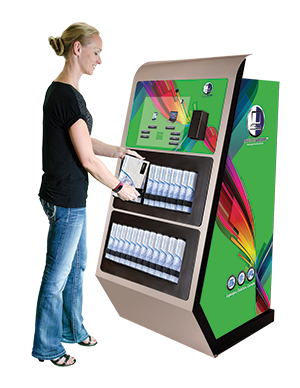 Patrons simply scan their library card to access a device from the kiosk. The machine can be programmed to fit a library’s local lending policies, and automated notifications help libraries manage the loaner program. For instance, a designated administrator can receive an email alert if a device hasn’t been returned on time or if a kiosk bay fails.
Patrons simply scan their library card to access a device from the kiosk. The machine can be programmed to fit a library’s local lending policies, and automated notifications help libraries manage the loaner program. For instance, a designated administrator can receive an email alert if a device hasn’t been returned on time or if a kiosk bay fails.
When a device is returned to an empty bay in the locked position, it’s docked to a power source for automatic recharging. Libraries can also choose to license Deep Freeze or a similar program for restoring the device to its initial state.
Perfect for meeting the power needs of users who bring their own mobile devices without having to rewire a library facility or run extension cords, ChargersAnytime kiosks hold, charge, and dispense portable 110 Volt chargers. A 30-inch-wide kiosk contains 12 or 24 charger bays.
The cordless chargers are about the size of an old VCR cassette tape. They include a three-prong electrical outlet and three USB outlets for charging multiple devices as once, such as a laptop, a cell phone, and a tablet.
Libraries can also request customized “combo systems” of kiosks that dispense both laptops and portable chargers. For instance, the top row of the kiosk could contain 12 portable charger bays, and the bottom row could contain six laptop bays.
LaptopsAnytime products are all manufactured in the United States; this year the company is opening a new facility that will increase its production capabilities by two and a half times the current capacity. The company expects to log more than 8 million checkouts of devices worldwide this year.
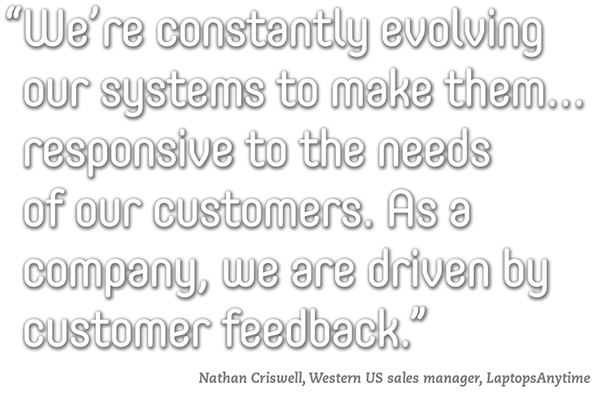
“We’re constantly evolving our systems to make them more durable and responsive to the needs of our customers,” Criswell says. “As a company, we are driven by customer feedback.”
D-Tech International
With offices in New Jersey and the United Kingdom, D-Tech is a leading supplier of systems for tracking, managing, and protecting library assets and forecasting demand using RFID technologies. Recently, the company has developed automated self-service technology for libraries.
D-Tech’s SMART R ange of lockers are fully customizable, all-in-one solutions for storing, charging, and lending out digital devices, as well as for patrons to browse and check out any kinds of materials or pick up items on hold. Whether libraries are looking for device charging, media vending, or self-service lending, the secure and modular SMART range of products allows them to mix and match features to create the perfect smart locker solution for their needs, says US Sales Director Anne Lawler.
SMART Hold is a self-service locker system that allows patrons to pick up and return reserved items outside of a library’s normal business hours, or even in a remote location. Patrons can open the lockers using their library card. The intelligent software that controls the system is compatible with any integrated library system (ILS) platform a library might use.
SMART Lend extends this concept to items that patrons haven’t already reserved, broadening a library’s reach into community centers, shopping malls, and other locations. The touch screen built into the locker system’s control panel allows users to browse the materials contained in the smart locker system’s collection and choose items they’d like to borrow.
SMART Chargeis a self-service locker system for storing, charging, and dispensing mobile devices to patrons—including laptops, tablets, Chromebooks, and mobile phones. Users can check out a fully charged device with their library card, and libraries can set their own rules and device lending periods.
Libraries can request their own SMART locker systems with any combination of these technologies, creating their own unique design that includes the specific feature sets they want, including holds, lends, and/or device charging.
 The individual locker bays are available in different sizes, so libraries can lend oversized items such as toys, games, tools, and other “library of things” objects. With a weather-resistant, anti-corrosive finish, the lockers can be placed either indoors or outdoors, and an ultra-bright backlit LED screen allows for use even in direct sunlight.
The individual locker bays are available in different sizes, so libraries can lend oversized items such as toys, games, tools, and other “library of things” objects. With a weather-resistant, anti-corrosive finish, the lockers can be placed either indoors or outdoors, and an ultra-bright backlit LED screen allows for use even in direct sunlight.
The SMART locker system is controlled via a cloud-based platform that makes remote management easy. The lockers are built using heavy gauge steel and are seam welded for extra strength and durability. Additionally, the lockers can be personalized with a library’s own branding. One year of maintenance is included at no extra charge, and libraries can purchase an additional service contract.
Continuing the theme of self-service, D-Tech offers a fully customizable library app that enables patrons to check out items with their phone using barcode or RFID technology. Called appIT, the system also lets users reserve or renew materials, check their account status, pay fines and fees, and further interact with the library from the palm of their hand. In turn, libraries can use the app to communicate with patrons, broadcast messages, solicit feedback, and otherwise engage with users.
The app is branded with a library’s own branding, so patrons can find it easily within Apple’s App Store or Google Play.
Brainfuse
Brainfuse has offered services such as live online tutoring, job search help, and veterans’ assistance to library patrons for nearly 20 years. Its latest service, CollegeNow, helps students and their families navigate the college application process. And later this year, Brainfuse will introduce a service to help adults learn practical English skills.
The company considers itself an extension of the library, says Director of Library Services Jack Rothstein. By subscribing to Brainfuse’s services, libraries can connect students and patrons with live tutors who can help with homework, critique a résumé, or aid veterans in getting the benefits they’re entitled to.
Applying for college can be a daunting process, especially for families who have never done this before. CollegeNow, which launched in October 2023, guides families through every step in the process, from filling out financial aid forms and searching for scholarships to preparing for an interview and writing the dreaded college essay. Brainfuse tutors will provide feedback on college essays and even lead students through mock interviews so they know what to expect.
Brainfuse is offering CollegeNow alongside its existing services: HelpNow , JobNow, and VetNow. HelpNow provides homework help and tutoring for kindergarteners through adult learners within a virtual whiteboard environment, with experienced teachers communicating with students through live online chat. JobNow connects patrons with experienced career counselors who can help them with all stages of the job-seeking process, and VetNow helps veterans and their families understand and apply for the benefits they qualify for.
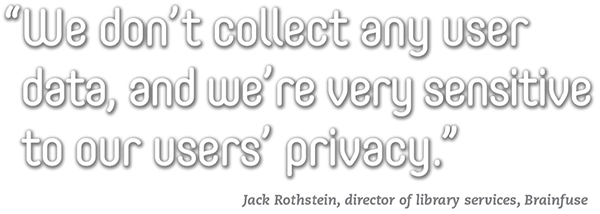
A key advantage of Brainfuse is that it combines live online chatting with a subject-area expert and a library of supporting e-resources.For instance, JobNow includes access to a résumé-building tool with dozens of templates for different careers. HelpNow includes access to various test-prep materials—and this spring, Brainfuse will be launching a separate paid service that includes access to a full library of test-prep content from Barron’s. Not only will patrons at subscribing libraries be able to take practice tests for standardized exams like the SAT and ACT, but they can also chat with a live tutor to go over the questions they got wrong.
Libraries in many communities serve patrons who are new to the United States or are still learning English; a new service that Brainfuse will introduce later this year can help these patrons navigate their everyday lives. With this service, which Brainfuse is offering in partnership with Oxford University Press, users will be able to chat with a live English tutor for help in understanding the language.
Unlike some other companies that offer live tutoring assistance, Brainfuse is a privately held US company, Rothstein says, adding: “We don’t collect any user data, and we’re very sensitive to our users’ privacy.” The company counts state library systems in California, Iowa, Missouri, New Mexico, Oklahoma, and Virginia among its customers.
OCLC
Based in Dublin, OH, the nonprofit global library organization OCLC is probably best known for producing and maintaining WorldCat , the largest online public access catalog in the world, as well as WorldShare, an electronic resource management and interlibrary loan system.
Both these services rely on innovations in technology to bring about a better experience for users. As artificial intelligence and machine learning technology transform key business practices across numerous industries, OCLC is naturally considering how it might unlock AI’s potential to help libraries and their patrons by using the technology wisely.
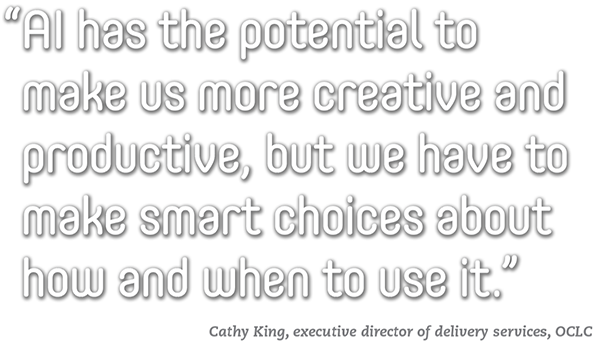
“AI has the potential to make us more creative and productive, but we have to make smart choices about how and when to use it,” says Cathy King, OCLC’s executive director of delivery services.
In an interview with Library Journal, King and Gina Winkler, OCLC’s executive director of metadata and digital services, shared some examples of how the organization is using AI and machine learning technology to streamline library workflows and enhance the user experience.
For instance, library users’ expectations are growing exponentially, driven by their experience with other services such as Amazon, which uses smart warehousing and logistics systems to promise 24-hour delivery on many items. Similarly, OCLC is experimenting with AI and machine learning to accelerate the fulfillment of requests through WorldShare, its global resource sharing network.
More than 11,000 libraries participate in WorldShare, making it the largest interlibrary loan system in the world. Thanks to AI, it’s also now the fastest, King says.
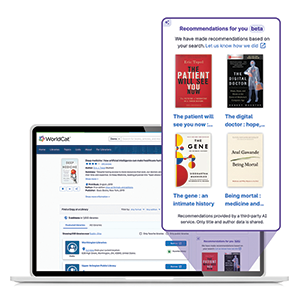 OCLC is leveraging machine learning algorithms to calculate not only which libraries have a requested item and are the closest geographically, but also which institutions are the fastest at fulfilling requests using historical fulfillment data. This “smart fulfillment” system has pared two days off the average time it takes for users to receive print materials, and it’s cut the delivery time of electronic resources in half.
OCLC is leveraging machine learning algorithms to calculate not only which libraries have a requested item and are the closest geographically, but also which institutions are the fastest at fulfilling requests using historical fulfillment data. This “smart fulfillment” system has pared two days off the average time it takes for users to receive print materials, and it’s cut the delivery time of electronic resources in half.
OCLC is also using AI to help reduce the number of duplicate records in WorldCat, its bibliographic service that describes the books, music, video, articles, and other materials at libraries worldwide.
As many as one in five new records created within WorldCat are duplicates of items that already exist within the system, Winkler says. This amounts to millions of duplicate records overall.
Historically, OCLC has relied on manual processes to find, evaluate, and eliminate duplicate records with the help of its user community. Now, the organization is leveraging AI to assist with this task. OCLC is using machine learning algorithms to identify pairs of duplicate records, and it presents these potential matches to its user community for verification.
Using this method, OCLC has identified more than 5 million pairs of duplicate records that would not have been discovered before, Winkler says—and she notes that the technology is more than 98 percent accurate in finding duplicate records. By reducing the number of duplicate records, OCLC is saving both researchers and library staff a great deal of time in their evaluation of search results.
In describing how OCLC is using emerging technologies like AI and machine learning to improve its services, King says the organization is thoroughly vetting both the results and the potential implications in collaboration with the library community. “Being transparent in how we’re using AI is key,” she observes.
Communico
Based in Stamford, CT, Communico offers an integrated suite of cloud-based software applications built specifically for libraries. These tools are designed to help libraries engage with their patrons more effectively “while giving time back to librarians for doing the things they went to school for,” says founder and CEO Paul Quelch.
Create is a content management system that helps libraries build beautiful, responsive websites without needing to know a single line of code. Broadcast is a digital signage application that turns any screen or device into a digital sign for wayfinding, security, or promoting library services. Attend helps libraries manage programs and events, including registration. Reserve helps libraries manage and promote their meeting rooms and equipment through a single interface. Schedule allows librarians to coordinate appointment-based services such as curbside pickup, tutoring, or career counseling.
Connect is an intuitive, custom-branded mobile app that lets patrons do almost anything they can do at a physical library location from the convenience of their phone. Communico has redesigned the app’s interface to make it even easier to use, Quelch says. The new home screen gives libraries an opportunity to promote all the services and events they have to offer, with applications such as Attend, Reserve, and Schedule baked directly into the interface.
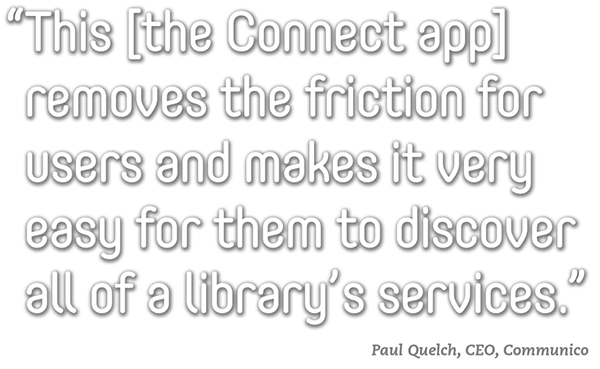
If a user sees an event they want to attend, they can register from the Connect app with a single click. “This removes the friction for users and makes it very easy for them to discover all of a library’s services,” Quelch says. From the “My Account” page, users can see all of their interactions with the library in one location, including all of the appointments and events they’ve signed up for.
Interactis a self-service checkoutapplication that also enables users to search the library’s catalog, schedule services, reserve meeting rooms, register for events, respond to surveys, and find their way around the library. It’s a software-only application that libraries can install on any device they choose as a cost-effective way to create self-service kiosks anywhere in their facility. For instance, libraries in Los Angeles have installed the application on tablets placed at the ends of their book stacks. The software can also be installed on devices outside the library, giving libraries a convenient way to extend their services throughout the community.
 Roam is a mobile point-of-sale solution for library staff to help customers from wherever they are, freeing them from behind circulation desks so they can interact with patrons throughout the building. Librarians can also use the app outside the library setting, such as for signing people up to receive a library card during community outreach programs and events.
Roam is a mobile point-of-sale solution for library staff to help customers from wherever they are, freeing them from behind circulation desks so they can interact with patrons throughout the building. Librarians can also use the app outside the library setting, such as for signing people up to receive a library card during community outreach programs and events.
Each of these applications is available as separate, standalone modules. However, when they’re bundled together, libraries and their patrons derive additional benefits through a tightly integrated user experience, Quelch notes.
This spring, Communico is launching a brand-new discovery application called Explore. Unlike most discovery services that are highly book and article-centric, Explore will allow libraries to present all the content, services, and programs they have to offer for a given search term—including special events, online courses, and “Library of Things” objects. The search results are presented through an engaging and easy-to-use graphic interface, similar to the search interface for Netflix and other streaming services.
Kingsley
For more than 60 years, Kingsley has been a leading manufacturer of library book returns, depositories, and equipment for handling materials. The company’s latest innovation is the DuraLight book carts and trucks for transporting items, including motorized carts for hands-free usage.

At under 40 pounds, the DuraLight Book Truck is “the lightest book truck in the world,” says Kingsley President and CEO Murray Morgan. Yet, it’s highly durable and virtually indestructible. “We believe that librarians should only have to worry about the weight of the contents, not the cart itself,” he notes.
The DuraLight Book Truck is made of lightweight, corrosion-resistant, and high tensile strength aluminum, “the same material used in airplanes and NASA rockets,” Morgan says. A video on the company’s website shows the book truck surviving a four-foot fall from a loading dock bay without even denting.
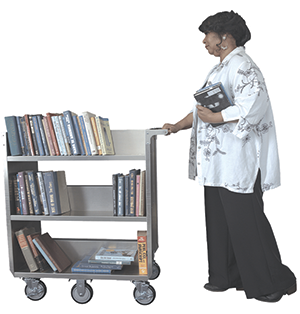 The cart is designed to be pushed and steered easily, with center casters for easy maneuvering and a tight turning radius. Its caster wheels are non-marring and plate mounted, with ball bearings for smooth rolling operation.
The cart is designed to be pushed and steered easily, with center casters for easy maneuvering and a tight turning radius. Its caster wheels are non-marring and plate mounted, with ball bearings for smooth rolling operation.
The book truck features three shelves and has a capacity of six cubic feet, enough for just over 200 books. It can handle a maximum load of 350 pounds.
Even with a lightweight, easily maneuverable cart, pushing more than 300 pounds of books and other items can be very cumbersome—which is why Kingsley has introduced new motorized carts that make it extremely easy for librarians to transport materials.
Powered by a lithium-ion battery, the DuraLight ERGO Powered Cart allows librarians to move up to 600 pounds of materials effortlessly. The cart is steered with an attached joystick. It maneuvers around corners and glides up and down ramps easily, and if it must stop on an incline, an electronic brake keeps the cart from rolling backwards.
The 50 Series cart has a maximum capacity of 9.3 cubic feet, enough to hold 300 books or 750 DVDs. The 60 Series cart has a maximum capacity of 13 cubic feet, enough to hold 412 books or 1,028 DVDs.
Kingsley is also coming out with a motorized version of the DuraLight Book Truck later this spring.
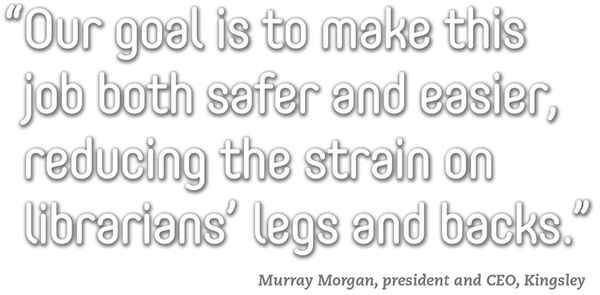
“Moving items around can be hard work for librarians,” Morgan says. “Our goal is to make this job both safer and easier, reducing the strain on librarians’ legs and backs.”
The new Book Truck and motorized carts join Kingsley’s existing high-capacityDuraLight carts, including the SafeGuard cart , which features a hinged metal lid. The carts fit neatly into Kingsley’s all-weather book drop receptacles, and when librarians are ready to bring the items inside, they can simply pull the cart out and close the lid, and the items stay dry. The SafeGuard lid also serves as an easy way to conceal the contents of the cart while it’s sitting around, making it less tempting for visitors to dig through.
Every cart includes a self-leveling floating tray that lowers as materials are added and raises as they are removed. This keeps the tray at the optimal height for collecting items and reduces the likelihood that they will be damaged when returned. Each floating tray has a thick felt pad at the bottom to cushion the fall of the first materials that are deposited. This felt pad is water-resistant, so if liquid does get into the cart, the pad won’t retain water or develop mold.
Kingsley is known as a leader in indoor and outdoor book return systems. For outdoor book returns, the company sells drive-up units, called the C-Series; walk-up units, called the S-Series ; and two-sided units, called the V-Series Dualside returns.
The drive-up system features an anti-collision design, with the depository hood extending approximately 13 inches from the curb for easier depositing of materials from vehicles. The depository opening on the C-Series is set back into the hood so that it’s surrounded on all four sides for additional weather protection. If any liquids do manage to make it in through the depository opening, an internal liquid diversion system is designed to divert them away from the collection area.
All the outdoor book return units are constructed with a rust-free, all-aluminum body. They are all weather, theft, and vandal resistant, ADA compliant when installed correctly, and include customization options with a modern look that won’t be an eyesore outside library buildings. By bundling the units with a matching book cart, libraries can save money on the cost of these items.
 Kingsley’s indoor book and media return units are available in metal or wood veneer finishes. The DuraWood line is a premium line of furniture-grade quality, hand-stained oak veneer return units that feature a depository chute to help guide materials properly into a cart. ColorWood units are made of melamine laminate that is scratch and stain-resistant to hold up well to abuse, even in high-traffic areas. With the ColorWood line, libraries can choose from eight different colors and three wood grains to match their existing library furniture or their school colors.
Kingsley’s indoor book and media return units are available in metal or wood veneer finishes. The DuraWood line is a premium line of furniture-grade quality, hand-stained oak veneer return units that feature a depository chute to help guide materials properly into a cart. ColorWood units are made of melamine laminate that is scratch and stain-resistant to hold up well to abuse, even in high-traffic areas. With the ColorWood line, libraries can choose from eight different colors and three wood grains to match their existing library furniture or their school colors.
In addition, Kingsley sells a locker system for library patrons to pick up items on hold, allowing contactless delivery and curbside pickup. The Book Valet material handling locker system consists of eight individual lockers that are 8.6 inches wide, 17.5 inches tall, and 17.5 inches deep. There are individual electronic combination locks for each locker. The system is made of 16-gauge, aircraft-grade aluminum for strength and all-weather use.
When patrons check out a book online, they can receive the code to one of the locker units. Then, they can pick up their book at their convenience simply by pulling the code up and entering it.
What’s more, the locker combinations can easily be reprogrammed by users. This means that libraries can also use the locker system as a means for patrons to store their laptops, phones, keys, purses, or any other valuables while they are using library resources.
The Book Valet is much less expensive than other similar locker systems on the market, Morgan says, costing under $5,000. A set of two 5-inch locking casters is also available, making the locker system easily portable.
International Library Services
International Library Services (ILS) provides library automation solutions designed to increase circulation and extend a library’s reach throughout the community.

The company’s main product, AutoLend Library, is an all-in-one solution that “allows librarians to provide what is essentially an unattended library,” says founder and CEO Fred Goodman. The machine enables patrons with a library card to borrow and return a wide range of materials, including books, audiobooks, DVDs, video games, and even Wi-Fi hotspots—all from a kiosk the size of a standard vending machine.
The AutoLend Library holds up to 400 items and can fit through a standard 36-inch doorway, giving it “the smallest footprint of any book lending machine on the market,” Goodman says. Libraries can place the machine in shopping malls, senior centers, airports, train stations, and other public areas, making their materials much more widely accessible to the community.
A built-in touchscreen allows users to browse for materials by category, title, author, or genre, and the touchscreen shows pictures of each item so that patrons can be sure of what they’re borrowing. Vinyl wraps with customizable graphics allow libraries to decorate each machine with their own specific branding.
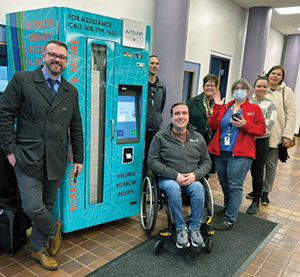 Aside from browsing for and checking out items, patrons can place a hold, pick up items on hold, return borrowed materials, and even download digital content to a tablet or other personal mobile device. “The AutoLend Library has been tremendously successful,” Goodman says.
Aside from browsing for and checking out items, patrons can place a hold, pick up items on hold, return borrowed materials, and even download digital content to a tablet or other personal mobile device. “The AutoLend Library has been tremendously successful,” Goodman says.
Another ILS product, Library Media Box, dispenses DVDs, CDs, audiobooks, and video games to card holders—like a Redbox system for libraries.
The Library Media Box holds up to 750 items. Like the AutoLend Library, it can be deployed in a remote location to extend a library’s reach within the community, or it can be positioned within a library building as a way for patrons to check out media materials for themselves without staff intervention.
The machine should be familiar to anyone who’s used a Redbox system before, Goodman says. As with Redbox, patrons can see which items are available in the machine before they leave home and can reserve them online.
Apart from providing a self-service option for patrons, another advantage of the product is tighter security, as nothing can leave the machine without being checked out first. “Media items seem to walk off the shelves as quickly as librarians put them out for display,” Goodman notes.
Pickup lockers emerged during the pandemic as a safe, contactless way for patrons to retrieve items they placed on hold from the library. The Intelligent Locker System from ILS allows patrons to pick up items on hold using their library card at all hours of the day, either inside a library’s lobby or in another public location.
The locker system is fully customizable, allowing libraries to configure the system’s towers with lockers that are four, seven, or 17 inches tall for distributing nontraditional items. “We’ve designed it to be extremely easy for the public to use and for librarians to load,” Goodman says.
All these products support both barcode and RFID technology, are ADA compliant, and integrate with any integrated library system software. Each one includes a full year of service and support at no additional charge, and extended service contracts are also available.
ByWater Solutions
A privately-owned company founded in 2009, ByWater Solutions provides implementation, hosting, support, consultation, and development services for open-source software used by libraries, such as the Koha integrated library system (ILS) and Aspen Discovery.
Used worldwide by public, academic, school, and special libraries, Koha is a scalable library management system with an easily configurable user interface. The software is adaptable for any library type and has been translated into many languages.
Koha also integrates with many third-party applications used by libraries, such as Microsoft Active Directory, OCLC WorldCat, Aspen Discovery, and Communico’s suite of
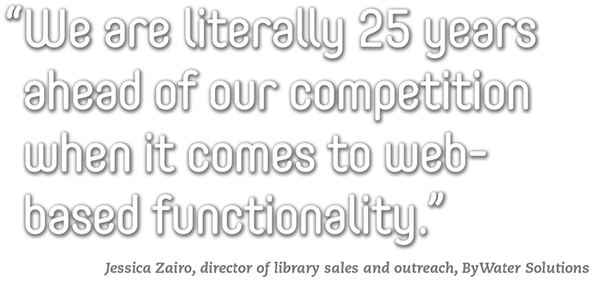
Since its first release in 2000, Koha has been natively web-based. “We see a lot of historically client-based products now starting to convert their ILS software into web-based,” says Jessica Zairo, director of library sales and outreach for ByWater Solutions. “Taking a client-based system and turning it into a web-based product has inherent issues relating to responsiveness, speed, and future development. Koha has none of these issues, as it has been natively web-based since its inception. We are literally 25 years ahead of our competition when it comes to web-based functionality.”
Aspen is a fully featured discovery system that integrates with e-content providers such as Hoopla and OverDrive. Aspen combines a library’s catalog with e-content, digital archives, and event information from major third-party providers like Communico and SpringShare, giving patrons comprehensive access to all of a library’s resources and materials in one place.
ByWater also hosts and supports Libki, a computer reservation booking, session, and print management system that allows time-limited access to computers on a network; FOLIO, a modular and cloud-based library services platform; Metabase , a data visualization and analysis platform; and CORAL, an electronic resources management system.
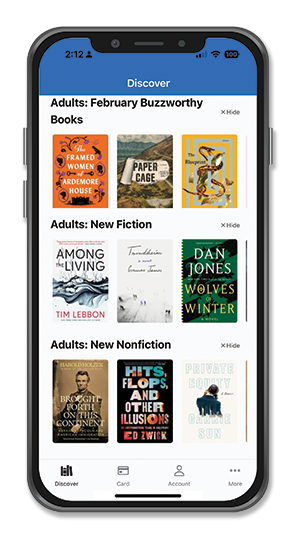 More than 2,500 libraries rely on ByWater to help them implement these open-source library solutions, and about 92 percent opt to have ByWater host the software for them, Zairo says. ByWater charges an annual service fee that is based on the size of a library’s collection, and in return, libraries don’t have to install or support the software for themselves.
More than 2,500 libraries rely on ByWater to help them implement these open-source library solutions, and about 92 percent opt to have ByWater host the software for them, Zairo says. ByWater charges an annual service fee that is based on the size of a library’s collection, and in return, libraries don’t have to install or support the software for themselves.
Zairo notes how far open-source software has come in the last decade or so. “In the past, open source was viewed as being not as inherently secure as proprietary software,” she says. “But that’s no longer the case. We’ve seen an explosion in the number of libraries making the shift to open-source platforms recently.”
For instance, the Cape Libraries Automated Materials Sharing (CLAMS) Network in Massachusetts, a nonprofit cooperative association consisting of 34 public libraries and one academic library across Cape Cod, Nantucket, and Martha’s Vineyard, recently signed on as a ByWater customer. So did the Ocean State Libraries consortium of 48 public libraries in Rhode Island.
“People like being part of a community,” Zairo says. They also like having a voice in the direction and development of the software they use, and that’s a key advantage of using open-source systems. “We work closely with our library partners to implement their suggestions,” she says, “and these enhancements become part of the core software for everyone.”
SPONSORED CONTENT
RELATED
ALREADY A SUBSCRIBER? LOG IN
We are currently offering this content for free. Sign up now to activate your personal profile, where you can save articles for future viewing









Add Comment :-
Comment Policy:
Comment should not be empty !!!